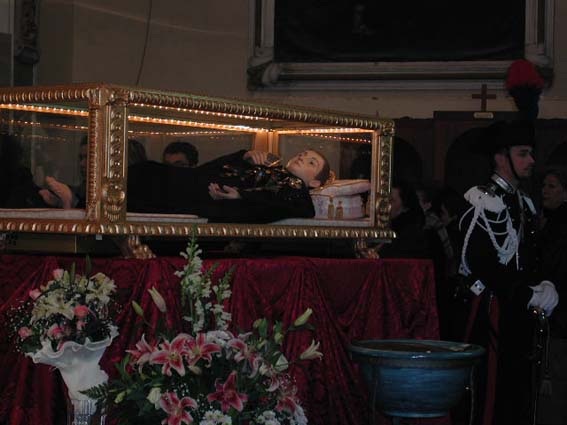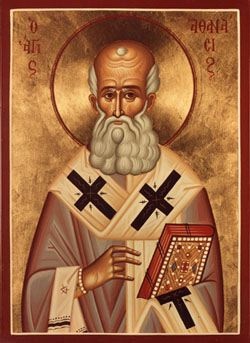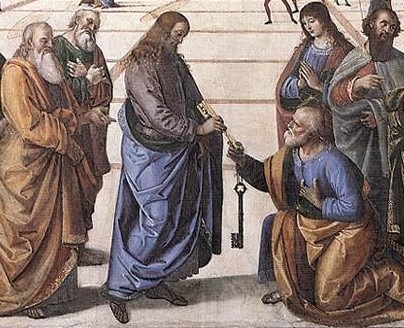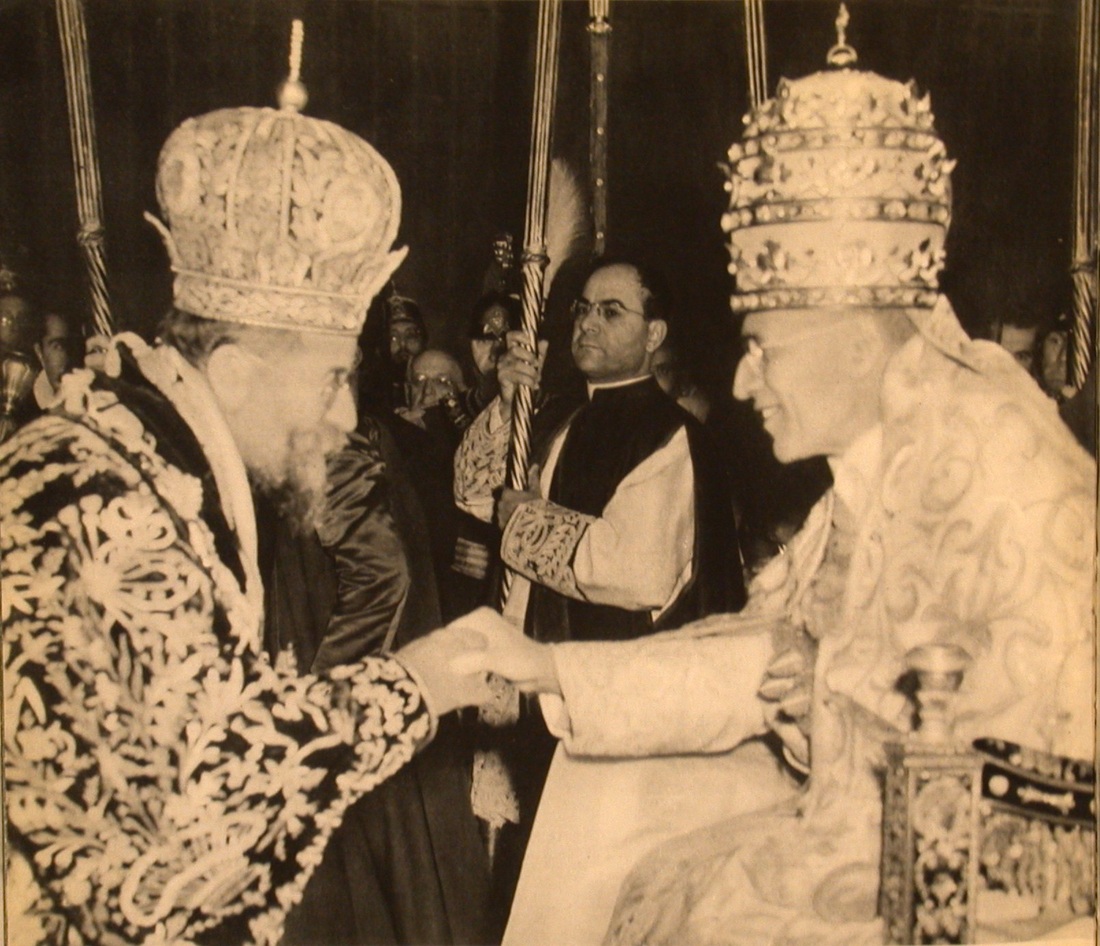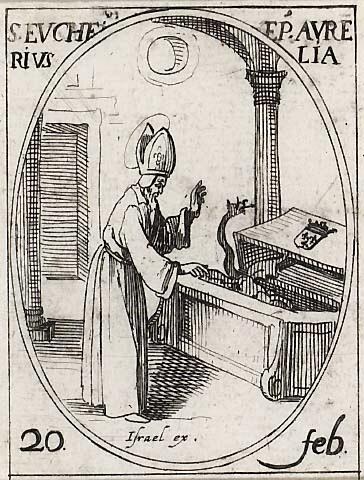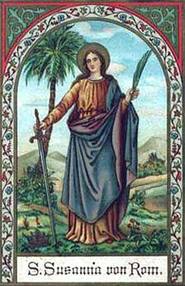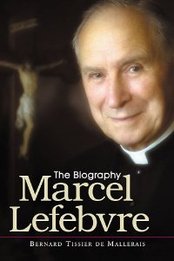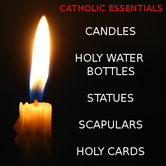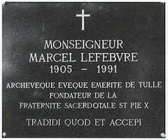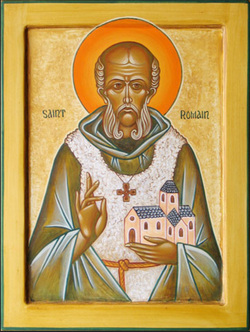
 St. Romanus was born in about the year 390 in upper Bugey. At the age of 35 he undertook to live as a hermit, in prayer and asceticism, in the region of Condat in the Jura mountains of southeastern France. His younger brother Lupicinus followed him there. They became leaders of a community of monks which included St. Eugendus. Romanus and Lupicinus founded several monasteries. These included Condat Abbey, which was the nucleus of the later town of S.-Claude, Jura), Lauconne (later S.-Lupicin, as Lupicinus was buried there), La Balme (Beaume) (later S.-Romain-de-Roche), where Romanus was buried, and Romainmôtier (Romani monasterium) in the canton of Vaud in Switzerland. Romanus was ordained a priest by St. Hilary of Arles in 444. He reposed in the grace of Christ the God-Man, in about the year 460. Holy Venerable Romanus, pray to God for us!
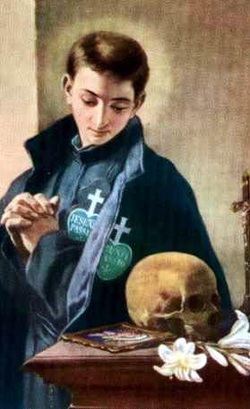 Gabriel, born at Assisi in Umbria of a respectable family, and called Francis in memory of his seraphic fellow-townsman, shewed from boyhood an excellent disposition of soul. As a youth, when studying letters at Spoleto, he seemed for a time to be allured by the empty beauty and pomp of the world. But by the gift of the merciful God, who had already called him to the perfection of a Christian life when he had fallen sick, he began to tire of the vanity of the world, and to desire immortal treasures alone. But to quicken his obedience to the call of God, it happened that as he saw the celebrated Image of the Blessed Virgin being carried with solemn pomp outside the precincts of the church of Spoleto, he experienced the flame of divine love, and at the same time decided to enter the Institute of the Clerks of the Passion of Jesus. Therefore, after overcoming no slight difficulties, he joyfully donned the somber habit in the secluded place of Morrovalle, and chose to be called Gabriel of Our Lady of Sorrows, to recall forever the memory of her joys and griefs. In the novitiate, day by day he became conspicuous for regular observance and for the exercise of all the virtues, and in a short time he came to be considered a pattern of perfect holiness, not only by his companions and his seniors, but also beyond the confines of the monastery; he became a sweet odour in Christ in every place. An assiduous devotee of the Lord's Passion, he spent days and nights meditating upon it. He was drawn by unbelievable zeal towards the Holy Eucharist, a memorial of that Passion; and when he nourished himself with it, he burned with seraphic ardour. There was nothing more noticeable than his filial piety towards the great Mother of God. He was accustomed to pay her honour for every type of devotion, but especially to contemplate her stricken and afflicted by the sufferings of Jesus, with such sorrow that he shed floods of tears. The sorrowful Virgin was, as it were, the whole reason of his being, and the teacher of the holiness that he had acquired. As a result all his associates shared the one opinion that this servant of God had been inspired from on high so that the cult of St. Mary of Sorrows through his example might receive a great increase.  Among other virtues, he especially loved Christian humility and obedience; for he considered himself the least of all. He therefore strove eagerly to do all the most menial work of the house, and he most diligently performed, not only the direct commands, but even the unexpressed wishes of his superiors. Curbing his senses, and accustoming himself to a life of austerity, he retained unfaded the flower of his virginity, and completely crucified to the world, he lived to God alone, enjoying an intimate familiarity with his Lord. And so, at Isola in the Abruzzi, filling the short span of his life with so many noble virtues, consumed by the fire of charity rather than by disease, and refreshed by the aid of the Mother of God, his soul flew to heaven in a most peaceful journey in the year 1862, at the age of twenty-four. Then, as he had been made illustrious by God through miracles, Pope Pius X added him to the number of the Blessed in heaven. Likewise, the Supreme Pontiff Benedict XV in 1920, two hundred years after the foundation of the Institute of the Passion, on the feast of the Ascension of the Lord, decreed the honours of the Saints to the blessed youth; and Pius XI extended his Office and Mass to the Universal Church. 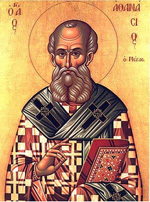 The majority of his ministry was dedicated to fighting against the Arian heresy. Arius, a priest of Alexandria, claimed Jesus was not truly God and that there was a time when the Son, the second person of the Trinity, did not exist. When Achillas bishop of Alexandria died in 313, Alexander was elected, and after that Arius threw off all disguise. Alexander was particularly obnoxious to him, although so tolerant at first of the errors of Arius that the clergy nearly revolted. Finally the heresy was condemned in a council held in Alexandria, and later on, as is well known, in the general Council of Nicaea, whose Acts Alexander is credited with having drawn up. An additional merit of this great man is that during his priesthood he passed through the bloody persecutions of Galerius, Maximinus, and others. It was while his predecessor Peter was in prison, waiting for martyrdom, that he and Achillas succeeded in reaching the pontiff, and interceded for the reinstatement of Arius, which Peter absolutely refused declaring that Arius was doomed to perdition. The refusal evidently had little effect, for when Achillas succeeded Peter, Arius was made a priest; and when in turn Alexander came to the see, the heretic was still tolerated. It is worth recording that the great Athanasius succeeded Alexander, the dying pontiff compelling the future doctor of the Church to accept the post. Alexander is described as "a man held in the highest honour by the people and clergy, magnificent, liberal, eloquent, just, a lover of God and man, devoted to the poor, good and sweet to all, so mortified that he never broke his fast while the sun was in the heavens." Alexander's epistle on the Arian heresy has survived and remains an important part of ecclesiastical literature. Alexander was a champion of orthodox Catholic teaching. He died in Alexandria two years after his return from the council. St. Alexander was also famous for his charity to the poor and his doctrine on life. According to tradition, she was born in Devon around 710, the daughter of St Richard, often referred to as ‘King’ of Wessex, and ‘Queen’ Wuna. It was a family of saints, a pedigree that would serve her well in the future: her uncle was the great St Boniface (Archbishop of Mainz) and her brothers were St Winnebald and St Willibald, who would later become Abbot of Heidenheim and Bishop of Eichstätt respectively. St Walburga received a solidly Christian upbringing. The family said their daily prayers before a wooden cross that was erected on their land and, in 720, she entered the double monastery at Wimborne (Dorset). Under the direction of St Tatta, the abbey had gained a reputation of learning and holiness, and it would prepare Walburga for her missionary years in Germany. Around the same time, her father and two brothers embarked on a pilgrimage to Rome and the Holy Land. However, her father developed a fever and died at Lucca, where he is venerated to this day as ‘St Richard the Pilgrim’ at the church of San Frediano. The brothers went on to Rome, where they split up – Winnebald joined a Benedictine monastery and Willibald travelled to the Holy Land. During this period St Boniface was busy consolidating the Church in Germany, establishing monasteries and bishoprics. His collaborators included, by the 740s, SS Winnebald and Willibald. It is perhaps no surprise that in 750 St Walburga travelled to Germany to assist her kinsmen in this great work. It is said that, as she crossed the Channel, a terrible storm arose, which was stopped only by Walburga’s prayers - the miracle was traditionally commemorated at Eichstätt on 4th August. She may have stayed in Antwerp, where she is venerated as patroness, before going to Mainz to meet her uncle. She then settled down at Tauberbischofsheim, under St Lioba, a relative and another member of the Wimborne community, who had moved to Germany in 748. It must have been a great joy to be near her brothers, after many years of separation, and Walburga eventually moved to Heidenheim, where Winnebald had founded a double monastery, based on the English model (as found at Wimborne). After his death in 761, Walburga’s surviving brother, Willibald, now bishop of Eichstätt, appointed her Abbess, with government over both the monks and nuns. She was also skilled in medicine and did much to look after the sick and dying.The legend contains various miracles worked during her life. One night, one of the monks refused to accompany the saint to her cell at night with a lit candle. Shortly afterwards, the nuns found the abbey illuminated by a mysterious light. The saint cried out: ‘O Lord, as a humble maid who committed my life to you since my youth, I thank you for granting this grace. You have honoured me in my unworthiness with the comfort of your light. This sign gives courage to the souls of your handmaids who are dependent on me. And you have driven out the darkness and our fear through the bright light of your mercy.’ When St Walburga died on 25th February 779, she was buried at Heidenheim. However, the double monastery did not survive long and under Willibald’s successor, Bishop Gerhoh, it was occupied by canons. Devotion to Walburga waned to such an extent that in 870, as workmen were restoring the church, the saint’s tomb was desecrated. The outraged saint appeared to the bishop, Otgar, complaining that her remains were being trampled upon ‘irreverently by the dirty feet of the builders.’ Shortly afterwards, the north wall of the church collapsed, which was widely interpreted as a sign from heaven. The body of Walburga was quickly exhumed and translated to Eichstätt on 21st September, and her cult was revived. A community of canonesses initially cared for the saint’s tomb, until a Benedictine Abbey of nuns was founded there in 1035, which survives to this day. During its long existence, the Abbey has founded many daughter-houses, including Minister Abbey in Kent and several across the Atlantic: Latrobe (Pennsylvania), Canyon City (Colorado), and Boulder (Colorado). The fame of St Walburga rests in the miracles claimed after her death rather than the details of her life. When the tomb was opened in 893, ‘the workmen found the venerable bones of our holy mother Walburga moistened as if with a film of spring water, so that they were able, as it were, to press droplets of dew-like liquid from them.’ This ‘oil’ (Walburgisöl) has been constantly flowing from Walburga’s shrine, between the months of October and February, for over 1,200 years, stopping only, we are told, during a period when the town was under interdict and after blood was shed in the church by armed robbers. The fame of St Walburga rests in the miracles claimed after her death rather than the details of her life. When the tomb was opened in 893, ‘the workmen found the venerable bones of our holy mother Walburga moistened as if with a film of spring water, so that they were able, as it were, to press droplets of dew-like liquid from them.’ This ‘oil’ (Walburgisöl) has been constantly flowing from Walburga’s shrine, between the months of October and February, for over 1,200 years, stopping only, we are told, during a period when the town was under interdict and after blood was shed in the church by armed robbers. 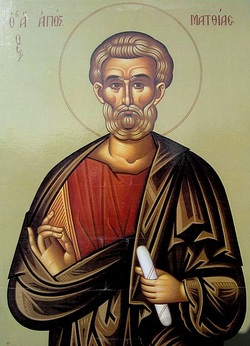 Matthias was one of the first to follow our Saviour, and he was an eye-witness of all his divine actions up to the very day of the Ascension. He was one of the seventy-two Disciples; but our Lord had not conferred upon him the dignity of an Apostle. And yet, he was to have this great glory, for it was of him that David spoke, when he prophesied that another should take the Bishopric (Ps. cviii. 8; Acts, i. 16.) left vacant by the apostacy of Judas the Traitor. In the interval between Jesus' Ascension and the Descent of the Holy Ghost, the Apostolic College had to complete the mystic number fixed by our Lord Himself, so that there might be "The Twelve" on that solemn day, when the Church, filled with the Holy Ghost, was to manifest herself to the Synagogue. The lot fell on Matthias; he shared with his Brother-Apostles in the Jerusalem persecution, and, when the time came for the Ambassadors of Christ to separate, he set out for the countries allotted to him. Tradition tells us, that these were Cappadocia and the provinces bordering on the Caspian Sea. The virtues, labours and sufferings of St. Matthias have not been handed down to us: this explains there being no proper Lessons on his Life, as there are for the Feasts of the rest of the Apostles. Clement of Alexandria records, in his Writings, several sayings of our holy Apostle. One of these is so very appropriate to the spirit of the present Season, that we consider it a duty to quote it. "It behoves us to combat the flesh, and make use of it, without pampering it by unlawful gratifications. As to the soul, we must develop her power by Faith and Knowledge." How profound is the teaching contained in these few words! Sin has deranged the order which the Creator had established. It gave the outward man such a tendency to grovel in things which degrade him, that the only means left us for the restoration of the Likeness and Image of God unto which we were created, is the forcibly subjecting the Body to the Spirit. But the Spirit itself, that is, the Soul, was also impaired by Original Sin, and her inclinations were made prone to evil:-- what is to be her protection? Faith and Knowledge. Faith humbles her, and then exalts and rewards her; and the reward is Knowledge. Here we have a summary of what the Church teaches us during the two Seasons of Septuagesima and Lent. Let us thank the holy Apostle, in this his Feast, for leaving us such a lesson of spiritual wisdom and fortitude. 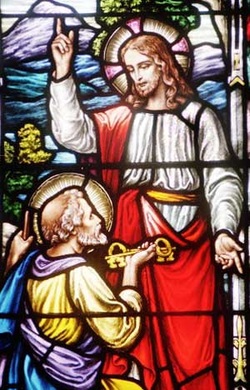 At that time: When Jesus came into the coasts of Caesarea Philippi, he asked his disciples, saying, Whom do men say that I the Son of man am? Sermon by St. Leo the Pope The Lord asked his disciples who men said that he was, and their answers were human as long as they were the answers of human reason, unilluminated by Divine light. At last, when the glimmerings of earthly conjecture were spoken, he whose Apostleship is the first in dignity, was the first to confess the Lord: And Simon Peter answered and said: Thou art the Christ, the Son of the living God. And Jesus answered and said unto him: Blessed art thou, Simon Bar-Jona, for flesh and blood hath not revealed it unto thee, but my Father which is in heaven. That is to say, For this cause art thou blessed, because my Father himself hath taught thee; the opinions of men have not beguiled thee, the voices of angels have not taught thee, not flesh and blood, but he, whose Only-Begotten Son I am, hath revealed me unto thee. Thus saith the Lord unto Simon Peter: And I say also unto thee, that thou art Peter. That is to say, Even as my Father hath revealed unto thee concerning me that I am God, even so now will I also reveal unto thee that thou art Peter; I am the sure Rock of defence, the Corner Stone, who make both one, I am the Foundation, besides which other can no man lay, and thou also art a rock, in my Strength made hard, and those things whereof I by right am Lord, into thy hand do I give them, that thou mayest bear rule over them, for me, and with me. And upon this rock I will build my Church, and the gates of hell shall not prevail against it. Upon this strength of thine, whereof I am the Strength, I will build mine eternal temple, and upon the truth of thy confession of me I will make to rise that my glorious Church whose spires shall pierce to heaven. Against this confession the gates of hell shall never prevail, neither shall the bands of death take hold upon it. Thus saith he that is faithful and true. And as this confession hath power to lift up to heaven them that make it, so is it able to thrust down to hell them that gainsay it. Wherefore it is said unto the most blessed Peter: And I will give unto thee the keys of the kingdom of heaven: and whatsoever thou shalt bind on earth, shall be bound in heaven; and whatsoever thou shalt loose on earth, shall be loosed in heaven. This power passed indeed to the other Apostles also; this the Lord's will had effect in them; but it is not in vain that it is written that that was given to one which passed from him to all. To Peter alone were the keys given, and Peter is set as the pattern for all them that bear rule in the Church to follow. There remaineth therefore the right of Peter, wheresoever his judgment decreeth justice. Neither is there anything too hard, or too lax, where is nothing bound and nothing loosed, save when Peter bindeth or looseth. "Today's solemn feast received from our forefathers the name of Saint Peter's Chair at Antioch, because of a tradition that on this day Peter, first of the Apostles, took possession of his episcopal Chair. Fitly, therefore, do the churches observe the day of his enthronement, the right to which the Apostles received for the sake of salvation, (which cometh to us in the churches,) when the Lord said: Thou art Peter, and upon this rock I will build my Church. It was the Lord himself who called Peter the foundation of the Church, and therefore it is right that the Church should reverence this foundation whereon her mighty structure riseth. Justly is it written in the Psalm which we so often chant: Let them exalt him also in the congregation of the people, and praise him in the seat of the elders. Blessed be God, who hath commanded that the holy Apostle Peter be exalted in the congregation! Worthy to be honoured by the Church is that foundation from which her goodly towers rise, pointing to heaven!
In the honour which is this day paid to the inauguration of the first Bishop's throne, an honour is paid to the office of all Bishops. The Churches testify one to another, that, the greater the Church's dignity, the greater the reverence due to her priests. While I confess how rightly godly custom hath exalted this Feast in the estimation of all the Churches, the more do I wonder at the growth of that unhealthy error which at this day causeth some unbelievers to lay food and wine upon the graves of the dead, as if souls once rid of the body had any longer any need of bodily refreshment." St. Augustine the Bishop 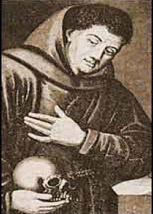 In the year 451 the fourth general council was called at Chalcedon to pronounce upon the Eutychian or monophysite heresy which was spreading very rapidly in the Eastern portion of the Church. Dioceses were being split into factions which, in some cases, elected rival bishops and refused communion to their opponents. The decision of the council, which totally condemned the heresy, was accepted at once by a great proportion of the Palestinian monks, but there were many exceptions. At the head of these was Theodosius, a violent and unscrupulous man who obtained sufficient following to enable him to expel Juvenal, Bishop of Jerusalem, and to gain possession of the see for himself. He then raised so cruel a persecution in Jerusalem that he filled the city with blood, as we learn from a letter of the Emperor Marcian. At the head of a band of soldiers he then proceeded to carry desolation over the country, although in certain places he met with opponents who had the courage to stand firm in their orthodoxy. Of these no one showed more determination than Severian, Bishop of Scythopolis, who received as his reward the crown of martyrdom. The soldiers seized him, dragged him out of the city, and then put him to death. 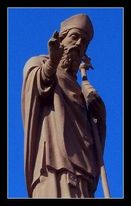 Born:696 Died:743 St. Eucherius was born in Orleans, France. He was very pious in his youth as he received a Christian upbringing and he was also highly educated. A sentence from Paul's first letter to the Corinthians made a big impression on him: "This world as we see it is passing away" (1 Corinthians 7:31). It made Eucherius realize that our lives on this earth are very short and that heaven and hell last forever. He decided to seek the joys of heaven by living for God alone. In 714, St. Eucherius left his rich home and entered a Benedictine abbey as a monk. There he spent seven years in close union with God. After the death of his uncle, the bishop of Orleans, the people asked for Eucherius to take his place. Eucherius was then only twenty-five and he was very humble. He did not want to leave his beloved abbey. With tears, he begged to be allowed to remain alone with God in the monastery. But finally, he gave in for love of obedience. Eucherius became a holy, wise bishop and did much good to his priests and people. A powerful man Charles Martel sold some of the Church's property to support his wars. Because Bishop Eucherius told him that was wrong, when Charles won the war, he had Eucherius taken prisoner. He was sent away to Cologne in Germany. The people there greeted him with joy and he was given the job of distributing the governor's alms. Later he was transferred to a fort near Liege. But the governor in whose charge Martel had placed the bishop was touched by Eucherius' meekness toward his enemies. Some time later, the governor quietly released the bishop from prison and sent him to a monastery. Here the saint spent all his time peacefully in prayer until his death in 743. 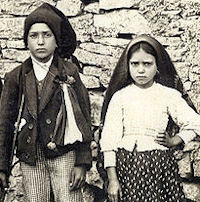 Blessed Francisco & Jacinta Marto Between May 13 and October 13, 1917, three children, Portuguese shepherds from Aljustrel, received apparitions of Our Lady at Cova da Iria, near Fatima, a city 110 miles north of Lisbon. At that time, Europe was involved in an extremely bloody war. Portugal itself was in political turmoil, having overthrown its monarchy in 1910; the government disbanded religious organizations soon after. At the first appearance, Mary asked the children to return to that spot on the thirteenth of each month for the next six months. She also asked them to learn to read and write and to pray the rosary “to obtain peace for the world and the end of the war.” They were to pray for sinners and for the conversion of Russia, which had recently overthrown Czar Nicholas II and was soon to fall under communism. Up to 90,000 people gathered for Mary’s final apparition on October 13, 1917. Less than two years later, Francisco died of influenza in his family home. He was buried in the parish cemetery and then re-buried in the Fatima basilica in 1952. Jacinta died of influenza in Lisbon, offering her suffering for the conversion of sinners, peace in the world and the Holy Father. She was re-buried in the Fatima basilica in 1951. Their cousin, Lucia dos Santos, became a Carmelite nun and was still living when Jacinta and Francisco were beatified in 2000. Sister Lucia died five years later. The shrine of Our Lady of Fatima is visited by up to 20 million people a year. 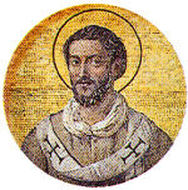 St Caius brother of St. Gabinus St Caius brother of St. Gabinus St. Gabinus was the father of St. Susanna. In the Spring of 293 AD, Diocletian announced the engagement of Maxentius Galerius to Susanna. Susanna refused the marriage proposal. Her father Gabinus and her uncle Caius supported this decision and encouraged her to keep her commitment to Christ. Her non-Christian uncles, Claudius and Maximus tried to persuade Susanna to marry Maxentius, after all this would make her Empress one day. In a conversation between the four brothers, Claudius and Maximus were converted to Christianity. The General Maxentius then came to the house, believing he could persuade Susanna to marry him. Susanna’s refusal soon led to the suspicion that she and other members of her family might be Christians. The Roman Consul Macedonius then called Susanna to Roman Forum and asked her to prove her loyalty to the state by performing an act of worship before the God Jupiter. She refused, confirming the fact that both she and other members of her family might well be Christian, There was no attempt to arrest her however, as she was a member of the Emperor’s family. Susanna refused the marriage proposal, not only because she was a Christian but in addition, she had taken a vow of virginity. When Diocletian on the eastern frontier learned of his cousin’s refusal and the reasons why, he was deeply angered, and ordered her execution. A cohort of soldiers arrived at the house and beheaded her. Her father Gabinus was arrested and starved to death in prison. Maximus and Claudius, together with Claudius’s wife Prepedigna and their children, Alexander and Cuzia are all martyred. Ironically the only survivor was Pope Caius, who had escaped and hid in the catacombs. These murders within Diocletian’s own family would foreshadow the last great persecution against the Christian church which the Emperor began in 303 AD. Diocletian’s daughter Valeria was divorced, and in June 293 AD married Maxentius who would succeed Diocletian in 305 AD. In the year 330 AD, a basilica was built over the site of the house of Susanna. It was first named San Caius in honor of the pope who had lived here. The bodies of Susanna and Gabinus were brought back from the catacombs and buried in the church. |
Archives
December 2014
Categories
All
While Archbishop Lefebvre Blog is provided free of charge, there are administrative and technical costs associated with making it available to subscribers worldwide and with operating this site. Contributions to offset these costs are appreciated, and may be made via the button below
|
